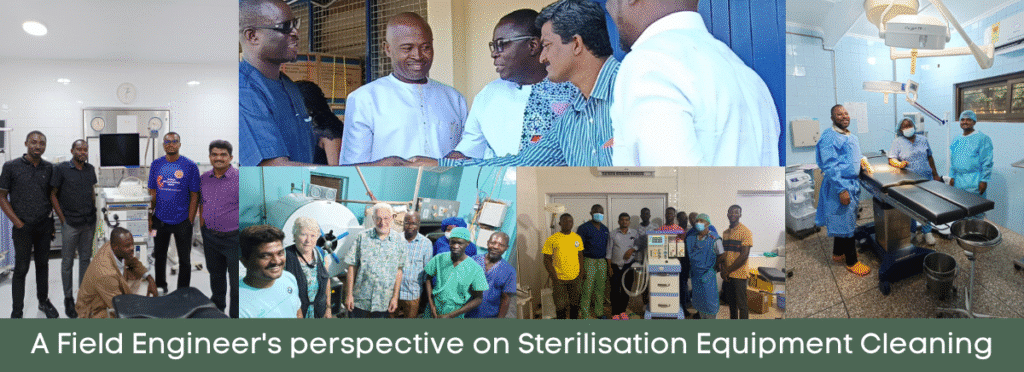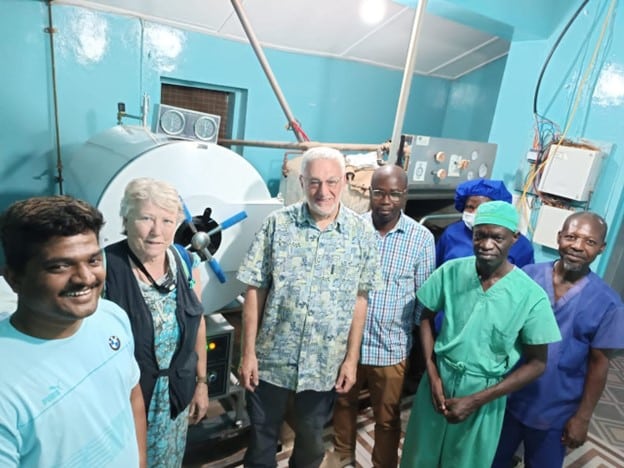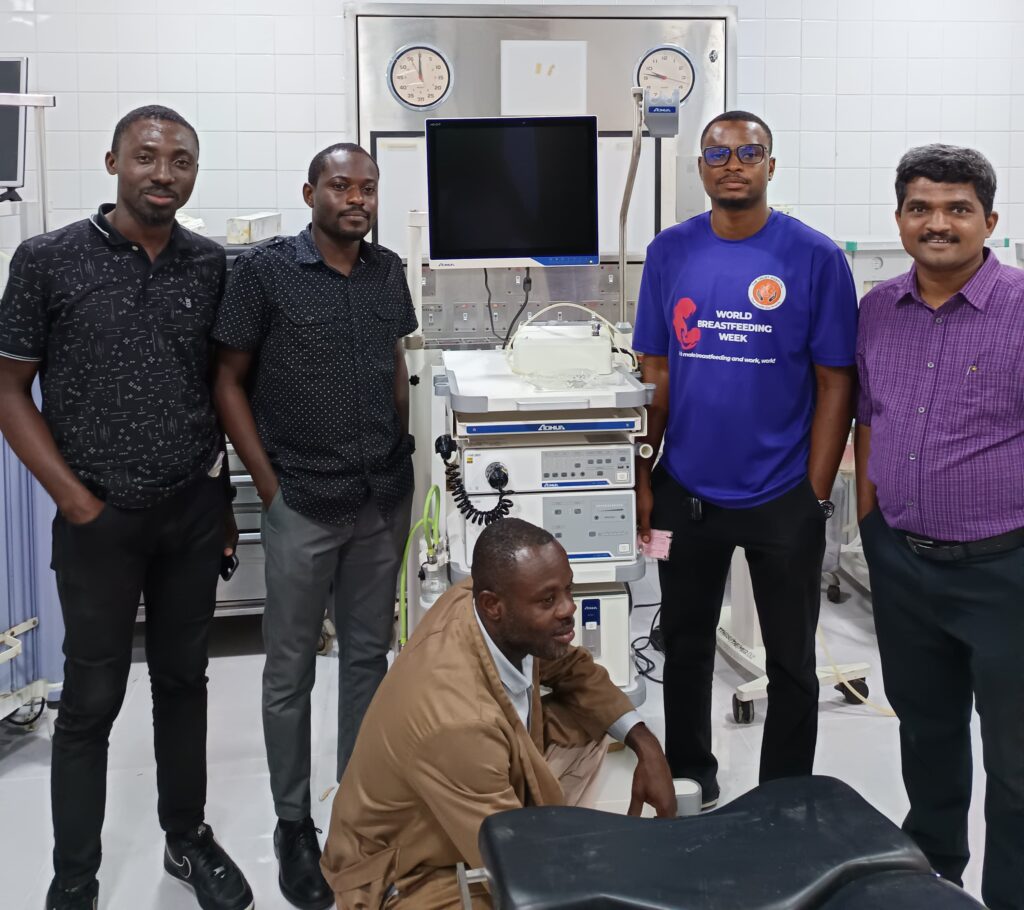A Field Engineer’s perspective on Sterilisation Equipment Cleaning

Why is regular sterilisation equipment cleaning so important? This article outlines the daily and weekly cleaning procedures for Sterilisation Equipment, and RO (Reverse Osmosis) Water Plant and provides guidance on repair and maintenance.
Anand Machindra Dalvi is Senior Service Manager at Advent International Limited. He has hands-on experience and a proven track record with sterilisation equipment, and has successfully repaired the STH-400 L Autoclave machine in Ghana, West Africa.

Why is Sterilisation Equipment Cleaning important?
Introduction: Hospital Sterilisation – A Critical Component of Infection Control
Infection control is a top priority in healthcare settings, and sterilisation plays a crucial role in preventing the spread of infections. Hospital sterilisation is a process that eliminates or destroys all forms of microbial life, including bacteria, viruses, and fungi, from medical equipment and surfaces. In this article, I will discuss the importance of sterilisation in hospitals, the procedures involved, and the significance of using sterilisation equipment and surgical equipment.
Pre-Installation Checklist for Autoclave and Plasma Sterilisation Equipment
There are three essential requirements for Autoclave and Plasma Sterilisation Equipment.
1. Stable Power Supply
A stable power supply source is crucial for the proper functioning of the equipment use an Uninterruptible Power Supply (UPS) with Automatic Voltage Regulation (AVR).
2. Room Size
The room size should be adequate to accommodate the equipment and allow for easy maintenance and operation.
3. RO Water Connection
A Reverse Osmosis (RO) water connection is required for the equipment.
Plumbing Requirements
There are three plumbing requirements for for Autoclave and Plasma Sterilisation Equipment.
RO Water Only
Only RO water should be used for plumbing to prevent contamination and ensure optimal performance.
Proper Plumbing
The plumbing should be done properly to prevent leaks and ensure smooth operation.
Manufacturer’s Guidelines
The manufacturer’s guidelines should be followed for plumbing and installation.
Consequences of Non-Compliance
If the sterilisation equipment is not maintained properly there will be operational consequences.
Frequent Problems
Failure to follow the manufacturer’s guidelines and use RO water may result in frequent problems with the sterilisation equipment.
Reduced Equipment Lifespan
Improper installation and maintenance may reduce the lifespan of the equipment.
Compromised Sterilisation
Inadequate plumbing and water quality may compromise the sterilisation equipment and process.

Autoclave
An autoclave is a device used to sterilise equipment and supplies by subjecting them to high pressure saturated steam. It is a critical component in healthcare settings, laboratories, and industries where sterilisation is essential.
Types of Autoclaves
Gravity Displacement Autoclaves
Use gravity to remove air from the chamber.
Pre-Vacuum Autoclaves
Use a vacuum to remove air from the chamber.
Steam Flush Pressure Pulse (SFPP) Autoclaves
Use a combination of steam and pressure pulses to sterilise equipment.
User Training for Autoclave and Plasma Sterilisation Equipment
Proper Operation
User training ensures that staff operate the equipment correctly, reducing the risk of errors and accidents.
Effective Sterilisation and Use of Sterilisation Equipment
Proper training ensures that staff understand the sterilisation process, including temperature, timer settings, and load placement.
Sterilisation Equipment Maintenance
Trained staff can perform routine maintenance tasks, such as checking pressure gauges, alarms, and indicators.
Training Topics for Sterilisation Equipment
There are six training topics to focus on.
1. Equipment Operation
Staff should be trained on how to turn on the supply, fill the RO water tank, and start the sterilisation procedure.
2. Temperature and Timer Settings
Staff should understand how to set the temperature and timer according to the load being sterilised.
3. Load Placement
Staff should be trained on how to properly place loads in the autoclave chamber.
4. Gauges, Alarms, and Indicators
Staff should understand how to monitor and respond to pressure gauges, alarms, and indicators.
5. Log Maintenance
Staff should be trained on how to log data, such as temperature, pressure, and cycle completion.
6. Door Operation
Staff should be trained on how to properly open and close the autoclave door, including tightening the handle.
Training Methods for Sterilisation Equipment
Hands-on Training
Staff should receive hands-on training on the equipment, including operation, maintenance, and troubleshooting.
Manufacturer’s Guidelines
Staff should be trained on the manufacturer’s guidelines and recommendations for equipment operation and maintenance.
Supervised Practice
Staff should practice operating the equipment under supervision to ensure they understand the procedures.
Training Frequency
Initial Training
Staff should receive initial training before operating the equipment.
Refresher Training
Staff should receive refresher training periodically to ensure they remain familiar with the equipment and procedures.
New Staff Training
New staff members should receive training on the equipment and procedures before operating the equipment.

How Autoclaves Work
Autoclave System with 3-Phase/Single-Phase Supply and Heating Elements
The autoclave system uses a 3-phase or single-phase electrical supply to power heating elements (coils) that boil Reverse Osmosis (RO) water to generate high-temperature steam. The steam is then directed through stainless steel pipes to the autoclave chamber.
Components
- Heating Elements (Coils): Electric coils that heat the RO water to produce steam.
- 3-Phase/Single-Phase Supply: Electrical supply system that powers the heating elements.
- Stainless Steel Pipes: Pipes that transport the steam from the heating elements to the autoclave chamber.
- Autoclave Chamber: The chamber where the steam is used for sterilization.
Operation
- Water Heating: The heating elements (coils) heat the RO water to a high temperature, producing steam.
- Steam Generation: The steam is generated and directed through the stainless steel pipes to the autoclave chamber.
- Sterilisation: The steam is used for sterilisation in the autoclave chamber.
Safety Features
- Temperature Control: The system includes temperature control mechanisms to prevent overheating.
- Pressure Relief Valve: A pressure relief valve is installed to prevent excessive pressure buildup.
- Electrical Safety: The system is designed with electrical safety features to prevent electrical shock.
Use 3 phase / Single phase supply and Heating Elements (coil)
- Steam Generation: Autoclaves generate steam, which is used to sterilise the equipment.
- Pressure Chamber: The equipment is placed in a pressure chamber, where the steam is introduced.
- High Pressure and Temperature: The steam raises the temperature and pressure inside the chamber, killing microorganisms.
Applications
- Medical Settings: Autoclaves are used to sterilise medical equipment, such as surgical instruments and gloves.
- Laboratories: Autoclaves are used to sterilise equipment, media, and waste.
- Industries: Autoclaves are used in various industries, such as food processing, pharmaceuticals, and biotechnology.
Benefits
- Effective Sterilisation: Autoclaves provide effective sterilisation, eliminating microorganisms and ensuring equipment safety.
- Efficient: Autoclaves are efficient, allowing for rapid sterilisation and minimising downtime.
- Environmentally Friendly: Autoclaves are a more environmentally friendly option compared to other sterilisation methods.
Why is Sterilisation and Sterilisation Equipment Important in Hospitals?
Sterilisation is essential in hospitals to prevent the spread of infections and ensure patient safety. Here are some reasons why sterilisation is critical.
Prevents the spread of infections
Sterilisation helps to eliminate microorganisms that can cause infections, reducing the risk of transmission to patients and healthcare workers.
Ensures patient safety
Sterilisation is critical to prevent surgical site infections, which can be life-threatening.
Reduces healthcare-associated infections (HAIs)
Sterilisation helps to reduce the incidence of HAIs, which are a major concern in healthcare settings.
Sterilisation Procedures
There are several sterilisation procedures used in hospitals, including the following.
Autoclaving
Uses high-pressure steam to kill microorganisms.
Dry heat sterilisation
Uses hot air to kill microorganisms.
Ethylene oxide sterilisation
Uses a gas to kill microorganisms.
Hydrogen peroxide gas plasma sterilisation
Uses a gas to kill microorganisms.
Importance of Using Sterilisation Equipment
Sterilisation equipment is critical to ensure that medical equipment and surfaces are properly sterilised. Here are some reasons why:
1) Ensures effective sterilisation: Sterilisation equipment helps to ensure that microorganisms are eliminated or destroyed.
2) Reduces the risk of infection: Proper use of sterilisation equipment reduces the risk of infection transmission.
3) Extends the life of medical equipment: Proper sterilisation and maintenance of medical equipment can help extend its lifespan.

Importance of Using Surgical Equipment
Surgical equipment is critical to ensure that surgical procedures are performed safely and effectively. Here are some reasons why.
Ensures patient safety
Surgical equipment is designed to ensure patient safety during surgical procedures.
Reduces the risk of infection
Proper use of surgical equipment reduces the risk of infection transmission.
Improves surgical outcomes
Proper use of surgical equipment can improve surgical outcomes and reduce the risk of complications.
Plasma Sterilisation
Plasma sterilisation is a low-temperature sterilisation process that uses a gas plasma to kill microorganisms. It is a popular method for sterilising heat-sensitive medical devices and equipment.
How Plasma Sterilisation Works
1. Gas Plasma Generation
A gas, such as hydrogen peroxide or peracetic acid, is introduced into a chamber and converted into a plasma state.
2. Reactive Species
The plasma generates reactive species, such as free radicals and ions, which interact with microorganisms.
3. Microbial Inactivation
The reactive species inactivate microorganisms by damaging their cell membranes and DNA.
Applications
Medical Devices
Plasma sterilisation is used to sterilise heat-sensitive medical devices, such as endoscopes and catheters.
Pharmaceuticals
Plasma sterilisation is used to sterilise pharmaceutical products, such as powders and liquids.
Food Processing
Plasma sterilisation is used to sterilise food packaging and equipment.
Benefits
Low Temperature
Plasma sterilisation is a low-temperature process, making it suitable for heat-sensitive materials. There are three main benefits as follows.
Effective Sterilisation
Plasma sterilisation is an effective method for killing microorganisms, including bacteria, viruses, and fungi.
Environmentally Friendly
Plasma sterilisation is a more environmentally friendly option compared to other sterilisation methods.
Types of Plasma Sterilisation
Hydrogen Peroxide Plasma Sterilisation
Uses hydrogen peroxide as the gas source.
Peracetic Acid Plasma Sterilisation
Uses peracetic acid as the gas source.
Ozone Plasma Sterilisation
Uses ozone as the gas source.
Validation and Quality Control
Biological Indicators
Used to validate the effectiveness of plasma sterilisation.
Chemical Indicators
Used to monitor the plasma sterilisation process.
Physical Parameters
Monitored to ensure optimal plasma sterilisation conditions.
Why Plasma Sterilisation Equipment is Needed
There are three main limitations of traditional sterilisation methods.
1. Heat Sensitivity
Many medical devices and equipment are heat-sensitive and cannot withstand high temperatures used in traditional sterilisation methods like cameras and flexible scopes.
2. Chemical Residues
Some sterilisation methods leave chemical residues on surfaces, which can be toxic or cause allergic reactions.
3. Inadequate Sterilisation
Some sterilisation methods may not be effective against certain types of microorganisms.

Benefits of Plasma Sterilisation
Low Temperature
Plasma sterilisation is a low-temperature process, making it suitable for heat-sensitive materials.
No Chemical Residues
Plasma sterilisation does not leave chemical residues on surfaces.
Effective Against Microorganisms
Plasma sterilisation is effective against a wide range of microorganisms, including bacteria, viruses, and fungi.
Industries That Benefit from Plasma Sterilisation
Medical Devices
Plasma sterilisation is used to sterilise medical devices, such as endoscopes, catheters, and implants.
Pharmaceuticals
Plasma sterilisation is used to sterilise pharmaceutical products, such as powders and liquids.
Food Processing
Plasma sterilisation is used to sterilise food packaging and equipment.
Regulatory Requirements
FDA Guidelines
ISO Standards
GMP (Good Manufacturing Practice) Regulations
Further reading
More articles in The Field Engineer’s blog

If you have any questions about this article or would like to learn more about the services The Field Engineer offers please use the contact form below to get in touch.




Responses